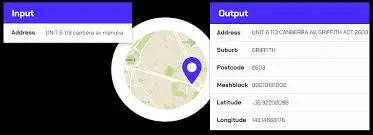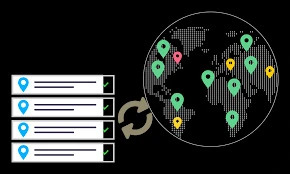#cleanvalidateaddress
Explore tagged Tumblr posts
Text
Effective Mortgage Marketing Strategies Every Broker Should Know
In the competitive world of mortgage brokering, effective marketing strategies are crucial to attract and retain clients. With so many brokers vying for attention, standing out requires innovative approaches and understanding how to communicate the value of your services. This article explores some of the most effective mortgage marketing strategies that every broker should know to enhance their business and reach a broader audience.

1. Leverage Content Marketing
Content marketing is one of the most powerful tools mortgage brokers can use to establish authority and trust in the market. By creating and distributing valuable, relevant, and consistent content, you can attract and retain a clearly defined audience. This strategy includes:
Blogging: Regularly updating your blog with relevant topics like mortgage tips, current trends, or homebuying advice can position you as an industry expert. Optimize your blog with SEO techniques to ensure it ranks well on search engines.
Video Content: Video marketing is growing in popularity. You can create explainer videos on complex mortgage topics or client testimonials to showcase your expertise and build trust.
Webinars and Tutorials: Offering free educational webinars or tutorials can attract potential clients who are in the decision-making process. This is a great way to showcase your knowledge and provide actionable insights to prospects.
2. Implement SEO Best Practices
Search Engine Optimization (SEO) is a must for any mortgage broker aiming to grow their online presence. Properly implemented SEO can drive organic traffic to your website and ensure you're visible when potential clients search for mortgage-related services.
Local SEO: Most people looking for mortgage brokers search locally. Ensure that your website is optimized for local search terms such as "mortgage brokers in [your city]". Registering your business on Google My Business is crucial to rank for local queries.
Keyword Optimization: Conduct keyword research to understand the terms potential clients are using. Incorporate long-tail keywords that reflect your specific services and target audience. Phrases like "best mortgage rates in [location]" or "how to apply for a mortgage" can attract qualified traffic.
Link Building: Build high-quality backlinks from reputable websites in the finance and real estate industries. This boosts your domain authority, helping your site rank higher on search engine results pages (SERPs).
3. Utilize Social Media Platforms
Social media marketing is another vital strategy for mortgage brokers. Social platforms offer a direct channel to communicate with prospects, share valuable content, and build your brand.
Facebook and Instagram Ads: Both platforms offer highly targeted advertising options, allowing you to reach specific demographics. Use Facebook's lead generation ads to collect potential client information and follow up with them.
LinkedIn: Since LinkedIn is a professional network, it’s perfect for B2B connections and networking with real estate agents, financial planners, and other professionals who can refer clients.
YouTube: YouTube offers an opportunity to create in-depth content such as how-to guides, explainer videos, or mortgage application walkthroughs. Video content also improves SEO, as YouTube is the second-largest search engine after Google.
4. Email Marketing
Email marketing is an effective way to nurture leads and stay in touch with potential clients who aren’t yet ready to commit. You can create a newsletter with mortgage tips, market updates, or featured home listings.
Personalization: Segment your email list based on your clients' needs and where they are in the buying process. Sending personalized emails that cater to their specific needs can significantly increase engagement and conversions.
Drip Campaigns: Use automated drip email campaigns to deliver timely information to potential clients. These can include mortgage rate updates, testimonials, and other content that builds trust over time.
5. Build Partnerships with Real Estate Agents
Mortgage brokers and real estate agents often work hand-in-hand. Developing strong relationships with real estate professionals can help you gain referrals and expand your network.
Attend Networking Events: Attend local real estate networking events to connect with agents who can refer clients your way.
Co-branded Marketing: Consider co-branded marketing efforts like hosting joint webinars, creating content together, or running targeted ad campaigns with a real estate agent. This can extend your reach and bring in more qualified leads.
6. Offer Excellent Customer Service
Customer service is an often-overlooked aspect of marketing. Word-of-mouth referrals remain one of the most effective marketing channels, and delivering top-notch service can lead to glowing reviews and recommendations.
Respond Promptly: Quick and clear communication is key when it comes to gaining a client’s trust. Be responsive to inquiries and provide comprehensive answers to any questions.
Customer Testimonials and Reviews: Encourage satisfied clients to leave reviews on platforms like Google and Yelp. Positive testimonials can serve as powerful social proof, attracting more clients to your services.
7. Utilize Paid Advertising (PPC)
While organic strategies are effective, pay-per-click (PPC) advertising can give you immediate visibility and results. Google Ads allows you to target specific keywords related to mortgage services, helping you reach clients actively searching for what you offer.
Target Local Searches: Focus your PPC efforts on local keyword searches to capture people looking for mortgage services in your area.
Retargeting Ads: Retargeting is a powerful way to reach users who have previously visited your site but didn't convert. This helps remind potential clients of your services, keeping you top of mind.
youtube
SITES WE SUPPORT
Clean & Validate Address– Wix
0 notes
Text
Top Mortgage Marketing Ideas to Help Mortgage Brokers Boost Leads in 2024
Introduction The mortgage industry is competitive, and staying ahead requires effective marketing strategies. With evolving consumer behavior and digital trends, mortgage brokers must adapt their marketing efforts to attract new leads. This article will explore the top mortgage marketing ideas for 2024 that will help mortgage brokers boost leads and grow their business.

Leverage Social Media Advertising Social media platforms like Facebook, Instagram, and LinkedIn offer targeted advertising opportunities for mortgage brokers. By using Facebook Ads, for instance, brokers can target users based on their location, interests, and even behavior, such as individuals looking to purchase a home or refinance their mortgage.
Actionable Tip: Create engaging content like home-buying tips, mortgage calculators, or success stories, and promote them through paid ads to drive traffic to your website.
Optimize Your Website for Local SEO Local SEO (Search Engine Optimization) is essential for mortgage brokers since most of their clients are within a specific geographic area. By optimizing your website for local search queries (e.g., "mortgage brokers near me"), you can rank higher in Google search results and attract potential clients.
Actionable Tip: Ensure your Google My Business profile is complete and optimized, and include local keywords in your website content, meta descriptions, and title tags.
Offer Valuable Content through Blogging Content marketing is a powerful way to attract and engage potential clients. By offering valuable insights through blog posts, mortgage brokers can establish themselves as experts in the industry. Write about topics such as "First-time Homebuyer Tips," "How to Improve Your Credit Score," or "Understanding Mortgage Rates."
Actionable Tip: Update your blog regularly with fresh, SEO-optimized content to rank for relevant keywords and attract organic traffic.
Host Webinars and Online Workshops With more people working from home, online webinars and workshops are an excellent way to reach potential clients. Mortgage brokers can host webinars on topics like "How to Qualify for a Mortgage" or "Refinancing Options for 2024."
Actionable Tip: Promote your webinar through email marketing, social media, and your website to generate leads and capture contact information for follow-ups.
Use Video Marketing to Build Trust Videos are one of the most effective marketing tools, especially for building trust in the financial industry. Mortgage brokers can create educational videos that explain the mortgage process, offer financial tips, or answer frequently asked questions. Posting videos on platforms like YouTube, Instagram, and Facebook can significantly increase engagement and lead generation.
Actionable Tip: Create a video series on home-buying tips or explain the mortgage process in easy-to-understand terms. Share these videos across your social media channels to drive engagement.
Invest in Email Marketing Email marketing remains one of the most cost-effective ways to nurture leads and stay in touch with potential clients. Mortgage brokers can create automated email campaigns that provide relevant content based on the lead’s stage in the buying journey.
Actionable Tip: Use personalized emails to follow up with potential clients who have shown interest in your services, offering them helpful resources or updates on current mortgage rates.
Partner with Real Estate Agents Building relationships with real estate agents can be a mutually beneficial marketing strategy. Real estate agents can refer clients to mortgage brokers, while brokers can offer pre-approval services to the agents' clients.
Actionable Tip: Attend local real estate events or networking groups to meet agents and offer co-branded marketing materials or joint promotions.
Utilize Retargeting Ads Retargeting ads allow you to reach individuals who have visited your website but didn’t convert. By placing retargeting ads across platforms like Google and Facebook, mortgage brokers can remind potential clients about their services, encouraging them to return to the site and complete an inquiry form.
Actionable Tip: Set up retargeting campaigns using platforms like Google Ads and Facebook Ads to convert website visitors into leads.
Offer Free Resources and Tools Providing free tools like mortgage calculators or eBooks can help capture leads. These tools offer valuable information to potential clients and, in exchange, you can collect their contact details for further follow-ups.
Actionable Tip: Create a downloadable eBook titled "The Ultimate Homebuyer Guide for 2024" and promote it through your website and social media to capture email addresses.
Conclusion In 2024, mortgage brokers need to adopt a multi-channel marketing approach to stay competitive. From leveraging social media and local SEO to offering educational content and webinars, these strategies will help mortgage brokers boost leads, build trust, and grow their business.
youtube
SITES WE SUPPORT
Clean & Validate Address– Wix
0 notes
Text
Address Cleansing Through Algorithms
In addition to real-time validation, businesses can significantly enhance their address data quality through address cleansing algorithms. Address cleansing, also known as data hygiene, is the process of cleaning and updating addresses in a database to ensure accuracy and completeness.

What is Address Cleansing?
Address cleansing is the method of identifying and correcting incorrect, incomplete, or outdated address information in a database. This can involve correcting misspellings, formatting errors, and ensuring that addresses conform to local postal standards.
Importance of Address Cleansing
Maintaining a clean address database is essential for several reasons:
Avoidance of Failed Deliveries: Inaccurate or outdated addresses can lead to failed deliveries, increasing costs for redelivery or refunds. Address cleansing helps ensure that all addresses are up-to-date and valid, reducing delivery failure rates.
Improved Customer Communication: Correct address data ensures that businesses can maintain clear and effective communication with their customers, whether through mail or other channels.
Enhanced Data Insights: Accurate address data can be used for deeper business insights, such as mapping customer locations, planning delivery routes, or analyzing sales patterns based on geography.
Compliance with Postal Regulations: Many postal services require that addresses follow a specific format. Address cleansing helps businesses adhere to these requirements, reducing the risk of penalties or delays.
Algorithms for Address Cleansing
Address cleansing is typically powered by sophisticated algorithms that use various methods to clean and standardize data.
Fuzzy Matching: Fuzzy matching algorithms are used to identify addresses that may have been misspelled or entered incorrectly. These algorithms can detect when two addresses are similar but not identical and correct the discrepancies.
Pattern Recognition: Algorithms can also recognize patterns in addresses, ensuring that they conform to postal standards, such as the correct order of elements (street name, city, postal code) and standard abbreviations.
Geocoding: By matching an address to a specific set of latitude and longitude coordinates, geocoding ensures that the address corresponds to an actual physical location.
Data Deduplication: Address cleansing algorithms often include deduplication processes, which identify and remove duplicate addresses from a database, reducing clutter and preventing multiple deliveries to the same location.
Cross-Referencing with Postal Databases: Advanced address cleansing tools can cross-reference addresses with national and international postal databases, ensuring that the addresses are current and valid.
Benefits of Address Cleansing Algorithms
Increased Efficiency: With algorithms automating the cleansing process, businesses can manage large volumes of data quickly and efficiently, reducing the time and effort required to maintain accurate address records.
Cost Savings: Clean, standardized addresses lead to fewer failed deliveries, which in turn reduces the costs associated with re-shipping, customer service interventions, and refunds.
Enhanced Marketing Efforts: Accurate address data ensures that marketing materials are delivered to the correct recipients, increasing the effectiveness of direct mail campaigns.
Improved Data Integrity: Algorithms ensure that all address data in your database is up-to-date and accurate, maintaining high data integrity across your systems.
Conclusion
Integrating the Google Address Validation API and leveraging address cleansing algorithms can significantly improve delivery accuracy, reduce operational costs, and enhance customer satisfaction. With real-time validation and data cleansing, businesses can maintain accurate address databases, leading to more efficient delivery processes and a better overall customer experience. By adopting these advanced tools, companies can stay ahead of the competition in a rapidly evolving digital landscape.
youtube
SITES WE SUPPORT
Clean & Validate Address– Wix
0 notes
Text
Improve Delivery Accuracy with Google Address Validation API Integration
In today's fast-paced digital world, ensuring accurate delivery is critical for both businesses and consumers. Address validation, which is the process of verifying and standardizing postal addresses, plays a vital role in ensuring that mail and packages reach their intended recipients without delays or errors. One powerful tool that businesses can leverage to enhance delivery accuracy is the Google Address Validation API. Integrating this API not only improves the quality of address data but also streamlines operations, reduces return rates, and increases customer satisfaction.

What is Google Address Validation API?
The Google Address Validation API is a service that allows businesses to validate and standardize addresses in real-time using Google’s comprehensive address database. This API is designed to correct and complete address information, making sure that the address provided is formatted correctly, contains all necessary elements (street, city, zip code), and matches an existing location.
Benefits of Integrating Google Address Validation API
Enhanced Delivery Accuracy: By validating addresses before a delivery is initiated, businesses can ensure that the package is sent to a correct and standardized address, minimizing the risk of failed deliveries.
Reduced Operational Costs: Failed deliveries due to incorrect or incomplete addresses can result in extra costs, including redelivery attempts, customer service intervention, and product returns. The Google Address Validation API helps to reduce these costs by minimizing delivery errors.
Improved Customer Satisfaction: Timely and accurate deliveries are essential for customer satisfaction. Validating addresses ensures that customers receive their packages on time, leading to fewer complaints and enhanced loyalty.
Real-Time Address Verification: The API allows businesses to validate addresses at the point of entry in real-time, whether it's during checkout on an e-commerce website or when inputting data into a CRM. This reduces the chance of typos, incomplete data, and invalid addresses.
Global Reach: Google’s address database covers a wide range of countries and regions, allowing businesses to validate international addresses with ease, making it an ideal solution for companies with a global customer base.
Customizable for Your Needs: The API can be customized to suit different business needs. Whether it’s address cleansing, autocomplete features, or batch validation, businesses can tailor the API to their specific operational processes.
How Google Address Validation API Works
Google’s Address Validation API leverages the Places API to provide real-time suggestions and validation as users input their address information. The process involves:
Input Parsing: As the user enters an address, the API breaks down the input into recognizable elements such as street name, number, postal code, city, and country.
Standardization: The API compares the input against Google's address database, correcting misspellings, adding missing elements, and ensuring the address adheres to the standardized format recognized by postal services.
Validation: After standardization, the API checks if the address exists in Google’s database. If it matches a known location, the address is validated.
Geocoding: For further accuracy, the API can also provide the geocoded location of the address in terms of latitude and longitude, which can be useful for delivery routing and planning.
Steps to Integrate Google Address Validation API
Obtain the API Key: To start using the Google Address Validation API, you will need to obtain an API key from the Google Cloud Platform.
Enable the API: Once you have the key, you can enable the Address Validation API from the Google Cloud console and configure it based on your requirements.
Customize for Use Cases: Depending on your business, you may want to add additional features such as address autocomplete or batch processing. These features can be integrated alongside the core validation process.
Integration into Platforms: The API can be integrated into your website or application, allowing real-time address validation during checkout, CRM data entry, or shipment processing.
youtube
SITES WE SUPPORT
Clean & Validate Address– Wix
1 note
·
View note